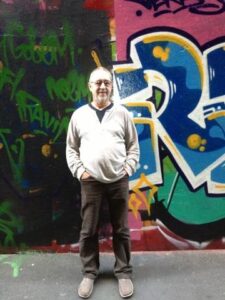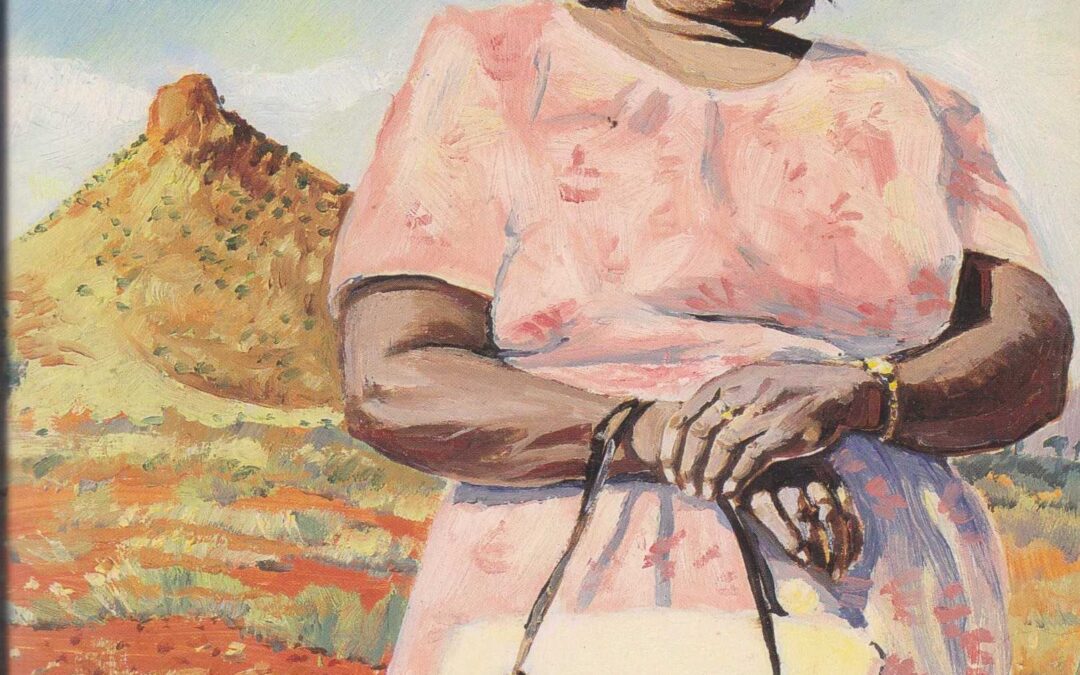by Bill Holloway
 Continuing our informal series on women in domestic service in Australian literature with one of the early accounts of an Indigenous woman forced into service by the infamous WA Chief Protector, AO Neville.
Continuing our informal series on women in domestic service in Australian literature with one of the early accounts of an Indigenous woman forced into service by the infamous WA Chief Protector, AO Neville.
Please note: Aboriginal and Torres Strait Islander people are warned this review contains the names, images and words of people who have passed away.
The story around When the Pelican Laughed is that in the early 1990s Lauren Marsh and Stephen Kinnane were working on an oral history project about Aboriginal women forced to work as servants, and one of the people they approached was Alice Nannup who knew Kinnane’s (Indigenous) grandmother. This grew into the memoir, When the Pelican Laughed, in which all the words are Alice’s.
‘You, Wari, you’re lucky to be with us, because you nearly got drowned one time.’ This is a story my mother told me about when I was very young. She told it to me in language.
 At the heart of Alice Nannup’s story is an issue that white Australians have nearly always swept under the carpet, and that is, to what extent were Aboriginal workers actually slaves. In The Great Australian Loneliness (1940) Ernestine Hill writes of pearling at Cossack (near Roebourne, south of Port Hedland and 1500 km north of Perth WA – and the area where, as it happens, Alice was born):
At the heart of Alice Nannup’s story is an issue that white Australians have nearly always swept under the carpet, and that is, to what extent were Aboriginal workers actually slaves. In The Great Australian Loneliness (1940) Ernestine Hill writes of pearling at Cossack (near Roebourne, south of Port Hedland and 1500 km north of Perth WA – and the area where, as it happens, Alice was born):
Nearly all the pearlers employed [A]boriginal divers… A bag of flour and a stick of tobacco bought a human life… From hundreds of miles inland the blacks were brought, men who had never seen the sea and now were to live and die in it. A dark sentence of history tells that when they refused to come voluntarily they were lassoed from horse-back, and dragged.
There was a form of agreement to be signed in Cossack… With a clumsy cross the natives signed their death warrants. Few of them lived longer than two years.
Alice, who was born in 1911, tells of her own position as a 19 year old on Ida Valley station 7 hours drive (maybe 200 km) from Leonora, itself a remote desert town 240 km north of Kalgoorlie in WA’s eastern goldfields.
Thinking back, I’d say Beeginup and Ida Valley were the two places where I was the most flat out. It was really terrible. All of us – Jess, Mary and myself – were just worked and worked. I was supposed to get five shillings a week there but they never paid me. They never paid any of us [and wherever she worked she almost never had days off].
This was on a ‘society’ property. “People would come from stations all around there, and the Bunning girls and Nellie Manford used to come up from Perth to have these big parties and play tennis.”
Alice was born on a station in WA’s north west, “Abydos Station, out from Port Hedland”. Her father was a small-scale cattleman, Tom Bassett, though Alice didn’t find this out until after she had been removed to Perth as an 11 year old. Alice’s mother mostly worked for Bassett, though she moved around a bit.
My mother’s name was Ngulyi, that’s her Aborigine name… She was born on Pilbara Station, which is between Roebourne and Marble Bar and she belonged to the Yindjibarndi tribe. My mother spoke five languages as well as English – Nyamal, Palyku, Kariyarra, Ngarluma and Yindjibarndi. I spoke Kariyarra and Ngarluma the most, and, of course, English.
These languages belong to the Ngayarda group, around and inland of Roebourne, bordered to the south by the Yamaji, and to the east by the Martu, the northernmost of the Western Desert peoples.
Wari (Alice) lived a quite happy life, an ordinary bush life with lots of cousins, at a time when all her people were station hands, until her mother was tricked into allowing a white family to take her south “to be educated”, where they delivered her into the hands of the Chief Protector and she was held at Moore River, not educated at all, but made to work until she could be sent out into ‘service’.
Bassett came down and attempted to recover her, but he was soon thwarted from even visiting, and she never saw him or her mother again. This is where the question of slavery comes in. Of course Aborigines under the 1905 Act were not owned by individuals and so could not be bought and sold, but they were effectively ‘owned’ by the State. They had no freedom of movement; they had to work where they were told; if they were paid, it was a derisory amount, half of which was paid into an account held by the Chief Protector and which they could sometimes beg to be allowed to spend (on necessaries); and by Alice’s account they worked tremendously long hours, seven days a week.
Late in her life, Alice discovered she had been the sole beneficiary of Basset’s will – £400 – but the money had been paid into an Aboriginal Affairs account, was lost, and they had made no attempt to tell of his death or of the earlier deaths of her mother and sister.
Alice mostly worked as a servant on farms, which involved both inside and outside work. The farms of course were all down south. The Chief Protector made sure that northerners only worked in the south and southerners only worked up north, to reduce the possibility of abscondment. Alice did in fact walk off Ida Valley and once picked up was able to resist any attempt to return her.
[A policeman] told us that Mr Neville had said we should go back to the station, and we should never have run away because it was dangerous. So we told the policeman how we were treated and that, and he said, ‘Well, I can’t force you, so you’ll have to come into Leonora.’
Here they found work until they were able to return to Perth. Alice knew Neville from having been a maid in his house, so she got him to give her a pass to go and work with a previous employer, but after only a few months, Neville wrote to her saying that Will, her boyfriend had the chance of a married position so she should return to Moore River, which was the only place he would allow Aboriginal people to be officially married.
They found work around Meekatharra but eventually settled at Geraldton, on the coast and began raising a large family through the Depression and WWII in a series of camps, shanties, reserves, and all too infrequently, reasonable houses, experiencing all the while both casual and official racism. Eventually she and Will split, I think Alice was a pretty forthright woman, and although she continued to live and eventually retire in Geraldton she was contacted by relatives still in Roebourne and was able to reconnect and make peace with her past.
This makes her contemporaneous with Nene Gare’s The Fringe Dwellers, which is set in Geraldton. Gare’s husband worked in Aboriginal Housing, so Nannup knew him and she was friends with another Aboriginal woman who worked with Nene Gare on the book.
Towards the end of her account she is able to say,
… I had thirteen kids, they had forty children between them, and their kids have had forty six. So altogether that makes ninety nine. I have another great grandchild due in 1992 which will make it one hundred – and maybe I’ll get a telegram from the Queen.
Alice Nannup was a sober and abstemious woman. Originally C of E, she moved on when a South African vicar began discriminating against the Blacks in his congregation, and found a home with the Seventh Day Adventists. And if she didn’t get the material rewards she deserved for her tremendous hard work, she ended up secure in her culture and with an enviable network of family and friends. She passed away, surrounded by family in Geraldton, in November 1995, aged eighty-four.
.
Alice Nannup with Lauren Marsh, Stephen Kinnane
When the Pelican Laughed
Fremantle Arts Centre Press, Perth, 1992.
224pp
Cover painting by Michael Francas (based on a photo of Alice, but with a background clearly of the country inland of Roebourne).
see also:
Stacey Roberts – Indigenous service (essay)
Caroline Leakey, The Broad Arrow (review)
Catherine Helen Spence, Clara Morison (review)
Louisa Atkinson, Gertrude the Emigrant (review)
Stacey Roberts – Female servants in the late C19th (essay)
Nene Gare, The Fringe Dwellers (review)
.
Bill Holloway, the author of this review, blogs at The Australian Legend. He is an old white guy the subject of whose (very) mature age M.Litt thesis was ‘The Independent Woman in Australian Literature’.






What an extraordinary life! Thanks for showcasing this, Bill. I can see why you suggested the extract from We of the Never Never for our Friday piece. The treatment of the Indigenous servants depicted in that story must have been typical.
It seems to me the wrong books become popular/well known. Yes, I’m talking about My Place. I also have a couple of other Indigenous WA lives that I wish were more widely disseminated –
Two Sisters, Ngarta and Jukuna, by two of the last women to ‘come in’ out of the desert; and
Lizzie Marrkilyi Ellis, Pictures from my Memory.
But we might squeeze in Follow the Rabbit-proof Fence one day, another 1990s book relating back to an earlier time.